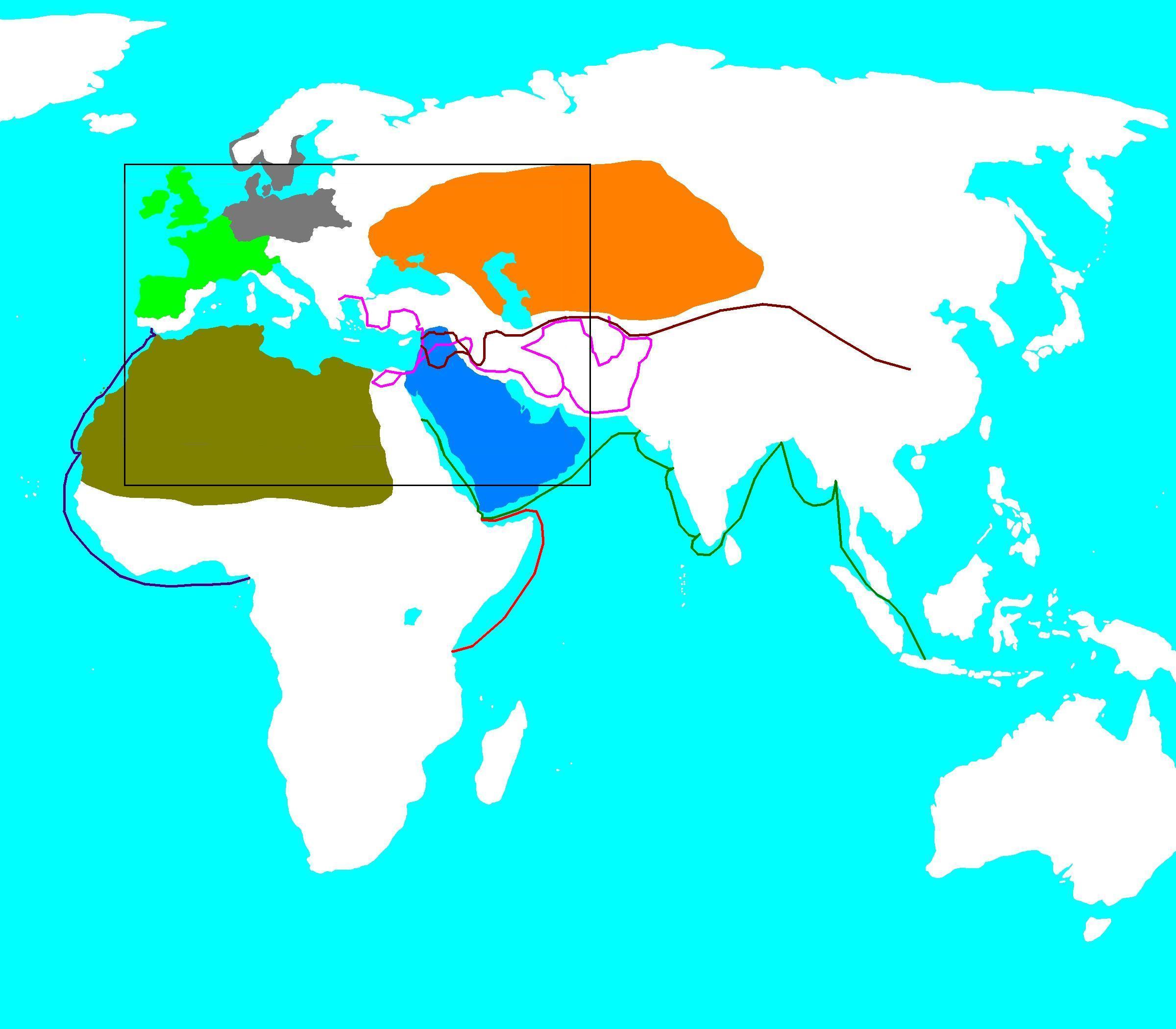Guide
Basics
Roleplay
Roleplay Rules & Guidelines Player Characters Non-Player Characters
Gameworld
Gameworld Timespan The Known World Anachronisms & Roleplay
Player Character
Character Development Character Statistics Character Skills
Roles
Rulers Governors Officers Slaves
Faction
Cultures Religions Government Forms Politics
Warfare
Land Battles Naval Battles Sieges Recruitment Mercenaries Covert Actions Battle Ploys
Military Units
Infantry Cavalry Mercenaries Unit Statistics Siege Engines Townwatch Navy
Economy
Settlements Construction Agriculture Trade Demographics Taxation
Geography
Gameworld

Gameworld
The game world consists of most of Europe, North Africa, and the Middle East. It is a vast world with great variety.
There are a lot of factions spread accross the world. Situated on the Italian peninsula for instance you have the fledgling civilization of Rome. Across the Mediterranean sea in Africa you can find Carthage with its large trade network. In the northern parts of Europe the barbarian tribes live, such as the Gauls and the Germans. In the southeast the Hellenic Diadochi fight eachother for supremacy over the former empire of the now long deceased Alexander the Great. Further east the Scythian hordes roam.
Scattered throughout the world are 850 settlements. These settlements range from small villages to large metropolises.
There are enormous deserts in the south, a huge mediterranean sea in the centre, massive mountain ranges like the Alps north of the Italian peninsula, and extensive forests on the European continent.
The world contains various resources, such as: livestock, fish, crops, rocks, and minerals.
Timespan
Time starts in the Iron Age, approximately 280 years before the common era. It ends in the year 85 AD, during the reign of the Roman emperor Domitian.
The Known World
The entire game world is known. Beyond the scope of the game world, there is some knowledge of other regions and civilizations outside of the game world.
The Ptolemaic Dynasty might know about the Nubians and the Ethiopians to the south of them. Likewise the Arabs might know about the Ethiopians through the ancient Arabic Yemenite kingdoms of Saba and the Minaeans.
The Greeks have knowledge of India through the conquests of Alexander the Great.
The Libyan tribes have extensive knowledge of the Sahara desert. Though the nomadic Libyans are primarily landbound, they have settled on the Canary Islands. The Canary Islands are the western most islands of the known world. These islands have been visited by the Greeks and the Phoenicians. Anything else in the Atlantic Ocean or beyond the Atlantic Ocean is entirely unknown.
Most knowledge of western Africa comes from the voyages of Hanno the Navigator. Hanno the Navigator was a Carthaginian explorer who lived in the 5th century before the common era.
Spice Route
Spices such as cinnamon, cassia, cardamom, ginger, and turmeric are known, and used for commerce. The Spice Route is initially controlled by the Indians and the Ethiopians. The Kingdom of Aksum pioneered the route in the 5th century before the common era. The Spice Route stretches as far as the island of Java.
Ivory Trade
The Ethiopians also traded in ivory. Ivory came from the tusks of African elephants.
Little else is known about Sub-Sahara Africa.
Alexander the Great
Citrus fruits like limes and lemons are recent introductions into the Near East. They are not yet widely known, except by the Hellenic Diadochi. Romans and Gauls for instance will at first be unfamiliar with them. Some Carthaginians might know about citrus fruits through their Phoenician connections, though they do not yet grow them. Limes and lemons were introduced to the Near East by Alexander the Great, when he returned from India.
The Silk Road
Plums and peaches are also recent introductions. Plums and peaches were introduced from ancient China through the Silk Road.
The Silk Road is established during the Han Dynasty. The period of the Han Dynasty in China begins in the year 220 before the common era. Initially trade along the Silk Road is maintained by Bactrian and Sogdian traders. The Parthians (Arsacid Empire) and the Seleucids (Seleucid Empire) are some of the first factions to come into contact with these traders.

Legend

Anachronisms & Roleplay
For roleplay purposes you should be aware that some crops and animals we know today, were unknown in iron age Europe, North Africa, and the Near East.
Unknown Resources
Crops like aubergines and sugarcane were introduced into the known world by the Arabs in the early middle ages with the rise of the Islamic faith. Both crops were native to India.
Citrus fruits like oranges were introduced into southern Europe after the crusades. Oranges likely came from northeast India or southwest China.
Plants like the potato, tomato, squash, and grapefruit were introduced to Europe during the Columbian Exchange. These plants are native to the Americas, which have not yet been discovered.